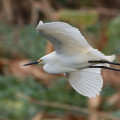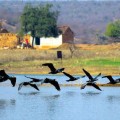This past Thursday, I was walking along the west drain of the Rio Grande, less than a mile from the Burger King, when I spotted an American beaver swimming on the surface and also diving off and on. Apparently it was conditioned to the presence of humans because it didn’t perform the famous Disney tail flapping. It’s always fun to see an iconic mammal that’s making a comeback. Nearly exterminated in New Mexico by the end of the nineteenth century due to trapping to make men’s top hats, the beaver was finally placed in protected status in the state in 1897. Since then, beavers have been reintroduced into their traditional habitats, including the Rio Grande Bosque, the cottonwood forest on either side of the river, one of the longest in the world. The dam-controlled river is too wide and fast for beavers to construct their dams, so they’ve had to adapt to making burrows on the banks of the river and the drains on either side of it, exactly like muskrats. The drains receive excess water from the irrigation ditches that is eventually returned to the river. The “bank-beavers,” as they’re called, mostly feed on the cambial tissue under the bark of cottonwoods and willows. Beavers living so close to human civilization is another example of the adaptation of wildlife; Albuquerque, for example, has the highest population of Cooper’s hawks of any American city. In the more isolated parts of the Bosque south of Albuquerque, casual visitors include black bears, elk, and the occasional mountain lion.
Beavers in the Bosque











